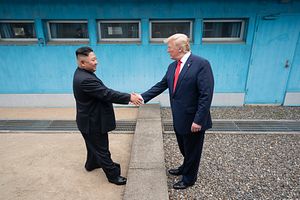According to a recent report, President Donald Trump is not interested in a new summit with North Korean leader Kim Jong-un before the 2020 Presidential elections. This is understandable, as Kim himself is likely waiting to see the outcome of the election. However, the challenge of North Korea will not be solved by a U.S. presidential election. Instead, deterrence and detente has rightly earned its place the best two-pronged strategy for dealing with the Hermit Kingdom.
America and its ally South Korea should focus on improving relations with Pyongyang while keeping these tools in mind. However, Washington is concerned that South Korea’s eagerness to open up tourism and trade with North Korea would violate sanctions. The U.S. ambassador to South Korea, Harry Harris, recently warned Seoul that it needs to coordinate with America to avoid trade actions that would trigger sanctions. Harris is right that Washington and Seoul need to coordinate more—however, that also means working together on confidence-building measures including trade.
The United States need not worry that its ally South Korea will speed ahead with full-on economic integration. Although Seoul would certainly like to do so, it knows that success with North Korea requires working with Washington. Unfortunately, Washington does not realize that minor inter-Korean trade or cultural exchanges would actually help build peace, rather than damage it or “reward” Pyongyang.
South Korea must understand America’s worries about allowing trade without making any progress on denuclearization. More importantly, Washington fails to understand that Pyongyang is still unlikely to give up its nuclear weapons—Pyongyang’s sole guarantor of regime survival. This blind spot impedes policymakers’ ability to focus on the need for continual conflict management.
Certainly, getting rid of North Korean nuclear weapons would be great for U.S. security. But as long as Pyongyang has the ability to kill millions of South Koreans and Americans, it would be wise to find ways to reduce tensions and communicate better. The consequence of U.S. policymakers insisting on an all-or-nothing deal is that confidence-building opportunities, including opening liaison offices, limited inter-Korean trade, or offering some sanctions relief for a nuclear freeze, are missed.
It appears Washington will keep insisting on final, fully verified denuclearization (FFVD) upfront from North Korea. That is a fool’s errand, but Washington can—and should—change its means of attaining FFVD. If America keeps the stated goal of FFVD for political reasons—and to save face—it should shift works towards incremental wins while striving to keep relations with North Korea calm and steady.
An all-or-nothing upfront approach to FFVD has failed and will keep failing. There is too much bad faith, history of bloodshed, and tension for a grand bargain to be realistic. Furthermore, North Korean leader Kim Jong-un knows his nuclear weapons are the only thing that has a shot at stopping Washington from forcefully toppling his regime, as was done to Iraq’s Saddam Hussein or Libya’s Muammar al-Gaddafi.
The most logical conclusion is that Washington must double-down on diplomacy coupled with deterrence in coordination with Seoul. Deterrence keeps the peace while engagement—with the goal of achieving detente where possible—lowers the risk of future tensions and escalation. Diplomacy does not require a wholesale removal of current United Nations sanctions without something in return. But it does require reasonable confidence-building actions such as improved communications, inter-Korean exchanges, and incremental deals with some sanctions relief included.
America and South Korea are two sovereign countries that want to maintain their security. North Korea has a long history of breaking agreements and even engaging in violence. This is why hawks and doves, liberals and conservatives, alike all recognize the need for a strong defense.
But wise leaders keep all their tools at their disposal—including diplomacy, trade, liaison offices, and other methods to reduce tensions. The threat of retaliation may keep the peace day-to-day, but an uncertain future between nuclear powers that don’t trust each other requires peacebuilding. Only through a long-term focus on decreasing hostility can the likelihood of war be drastically lowered and any movement on denuclearization be possible.
History shows that all this is both necessary and desirable. President Richard Nixon opened trade with a previously-hostile China and President Ronald Reagan signed arms control agreements with America’s Cold War nemesis the Soviet Union. Both of these leaders focused on defense to protect the United States and its allies, and then—from a position of strength and mutual-respect—worked to get along with America’s great rivals. Having a mighty military makes a country strong, but so does having the foresight to try diplomacy when tensions threaten to spiral into a nuclear war.
Washington and Seoul must work together on deterrence and detente. Neglecting either of these tools would be a mistake.
John Dale Grover is a fellow with Defense Priorities. He is also an assistant editor at The National Interest and a Korean studies fellow at the Center for the National Interest. His articles have appeared in Real Clear Defense, The Diplomat, Defense One, Fox News, and the American Conservative.
































